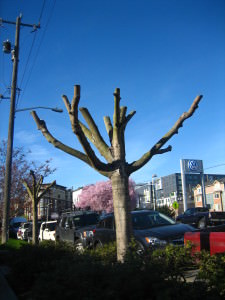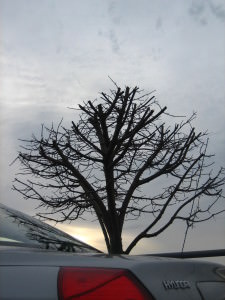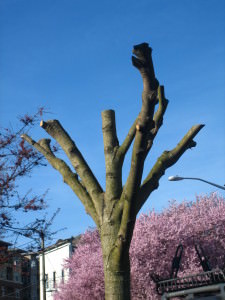Tooltip Text
The pictures accompanying this blog posting show trees photographed in March, 2015 in the Seattle area. Standing in front of two prominent Ballard businesses, they have been topped dramatically.
As I look at these topped trees, I have to believe that the business  owners (or their agents) simply didn’t realize what was going to be done. The owners probably asked their landscape maintenance company to “cut the trees back” for some reason. It’s hard to determine what that reason could have been. They weren’t growing into wires. They weren’t blocking views of/ from the businesses in question. I suppose someone looked at them and just decided that it was time to do something to them.
owners (or their agents) simply didn’t realize what was going to be done. The owners probably asked their landscape maintenance company to “cut the trees back” for some reason. It’s hard to determine what that reason could have been. They weren’t growing into wires. They weren’t blocking views of/ from the businesses in question. I suppose someone looked at them and just decided that it was time to do something to them.
Why is topping so disastrous for trees? First of all, the trees have no way to seal off these wounds, because the cut has been made through the phloem and xylem of the tree. Wound sealing chemicals exist at the collar of branches. This is the area at the base of a branch where it joins a larger branch. It looks somewhat like the crotch of a pair of pants. These trees will begin to rot back from these topping cuts, creating weak and dangerous branches (if any are left). Secondly, all the apical shoots have been removed from the ends of these branches. In fact, in one case all the branches have been removed. The apical bud/shoots, the ones at the ends of a branch or the leader in a tree, secrete a chemical that causes all the shoots below them to behave. That is, the chemicals from the apical shoots regulate the growth of the “adventitious buds” below them. When the apical buds/shoots or leaders are removed, that chemical disappears and all the lower shoots go crazy and try to become apical shoots by growing straight up into the air. This is what we mean when we say a tree is full of “water sprouts,” or shoots that grow straight up with no branching.
the phloem and xylem of the tree. Wound sealing chemicals exist at the collar of branches. This is the area at the base of a branch where it joins a larger branch. It looks somewhat like the crotch of a pair of pants. These trees will begin to rot back from these topping cuts, creating weak and dangerous branches (if any are left). Secondly, all the apical shoots have been removed from the ends of these branches. In fact, in one case all the branches have been removed. The apical bud/shoots, the ones at the ends of a branch or the leader in a tree, secrete a chemical that causes all the shoots below them to behave. That is, the chemicals from the apical shoots regulate the growth of the “adventitious buds” below them. When the apical buds/shoots or leaders are removed, that chemical disappears and all the lower shoots go crazy and try to become apical shoots by growing straight up into the air. This is what we mean when we say a tree is full of “water sprouts,” or shoots that grow straight up with no branching.
How can you, as a homeowner, make the right choice regarding your mature or maturing trees? First, consider the mature height and width of the tree you are planting. A tree can’t be kept smaller than its genetic programming determines. Secondly, consider any views that may be blocked, whether yours or someone else’s, along with overhead wires or other structures the tree may affect. Recent legal activity in Bellevue, Washington showed that a court may very well side with a neighbor and have a mature tree removed if it blocks views. Finally, hire a certified arborist to prune your trees appropriately.
mature or maturing trees? First, consider the mature height and width of the tree you are planting. A tree can’t be kept smaller than its genetic programming determines. Secondly, consider any views that may be blocked, whether yours or someone else’s, along with overhead wires or other structures the tree may affect. Recent legal activity in Bellevue, Washington showed that a court may very well side with a neighbor and have a mature tree removed if it blocks views. Finally, hire a certified arborist to prune your trees appropriately.
There is nothing anyone can do to restore these trees to their former beauty, however there is one more cut to be made on these poor trees: three inches from the ground.

